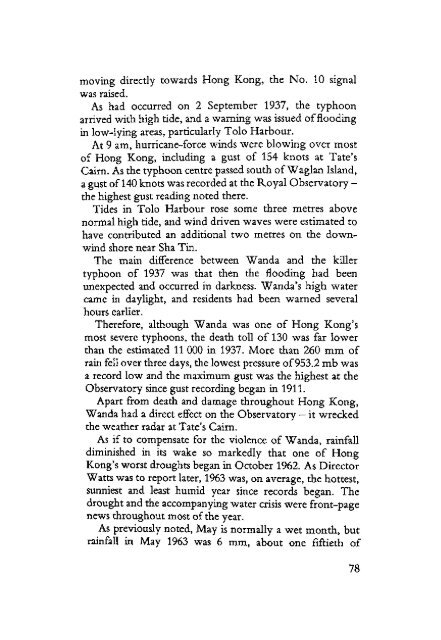Royal - HKU Libraries - The University of Hong Kong
Royal - HKU Libraries - The University of Hong Kong
Royal - HKU Libraries - The University of Hong Kong
Create successful ePaper yourself
Turn your PDF publications into a flip-book with our unique Google optimized e-Paper software.
moving directly towards <strong>Hong</strong> <strong>Kong</strong>, the No. 10 signalwas raised.As had occurred on 2 September 1937, the typhoonarrived with high tide, and a warning was issued <strong>of</strong> floodingin low-lying areas, particularly Tolo Harbour.At 9 am, hurricane-force winds were blowing over most<strong>of</strong> <strong>Hong</strong> <strong>Kong</strong>, including a gust <strong>of</strong> 154 knots at Tate'sCairn. As the typhoon centre passed south <strong>of</strong> Waglan Island,a gust <strong>of</strong> 140 knots was recorded at the <strong>Royal</strong> Observatory -the highest gust reading noted there.Tides in Tolo Harbour rose some three metres abovenormal high tide, and wind driven waves were estimated tohave contributed an additional two metres on the downwindshore near Sha Tin.<strong>The</strong> main difference between Wanda and the killertyphoon <strong>of</strong> 1937 was that then the flooding had beenunexpected and occurred in darkness. Wanda's high watercame in daylight, and residents had been warned severalhours earlier.<strong>The</strong>refore, although Wanda was one <strong>of</strong> <strong>Hong</strong> <strong>Kong</strong>'smost severe typhoons, the death toll <strong>of</strong> 130 was far lowerthan the estimated 11 000 in 1937. More than 260 mm <strong>of</strong>rain fell over three days, the lowest pressure <strong>of</strong> 953.2 mb wasa record low and the maximum gust was the highest at theObservatory since gust recording began in 1911.Apart from death and damage throughout <strong>Hong</strong> <strong>Kong</strong>,Wanda had a direct effect on the Observatory - it wreckedthe weather radar at Tate's Cairn.As if to compensate for the violence <strong>of</strong> Wanda, rainfalldiminished in its wake so markedly that one <strong>of</strong> <strong>Hong</strong><strong>Kong</strong>'s worst droughts began in October 1962. As DirectorWatts was to report later, 1963 was, on average, the hottest,sunniest and least humid year since records began. <strong>The</strong>drought and the accompanying water crisis were front-pagenews throughout most <strong>of</strong> the year.As previously noted, May is normally a wet month, butrainfall in May 1963 was 6 mm, about one fiftieth <strong>of</strong>78
















